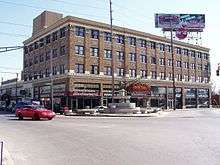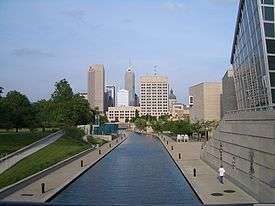Indianapolis Cultural Districts
Indianapolis has seven designated neighborhoods as Cultural Districts: Broad Ripple Village, Massachusetts Avenue, Fountain Square, the Wholesale District, the Canal & White River State Park, Indiana Avenue, and Market East.
Broad Ripple Village

Originally an independent municipality, Broad Ripple was annexed by Indianapolis in 1922.
It currently hosts an active social scene, fueled by the near presence of Butler University. A large number of private art galleries, bars, and independently owned restaurants line the Village's streets. There are various venues for eating, entertainment and shopping. There are several restaurants that you can get a good variety of food such as Chinese, Indian, Thai. For entertainment, there is comedy, sports bars, and two brewpubs.
Massachusetts Avenue
Massachusetts Avenue offers some of the city's most visible theaters and art galleries. Located just a few blocks northeast of Monument Circle, Massachusetts Avenue was designed in 1821 as one of Downtown's four original diagonal streets and began as a commercial artery that mainly served the surrounding residential area. The Avenue gained popularity as service-oriented businesses sprung up with the development of streetcar lines. The Avenue grew continuously between 1870 and 1930.
Bernard Vonnegut, grandfather of author Kurt Vonnegut, and Arthur Bohn designed the Athenaeum in 1893 as a home for German societies in Indianapolis to gather. Both were American-born sons of German immigrants, a culture that had a strong influence in the area around this time. Following these many years of good fortune and commercial growth, this area and all of Downtown fell into economic decline following World War II once Indianapolis lost its importance as a railroad hub.
Gentrification in the 1990s propelled the area from squalor to one of the city's more fashionable addresses. Currently, redevelopment of "Mass Ave" focuses on fostering locally owned shops, theaters, and restaurants. The once destined-for-demolition Athenaeum building now houses the American Cabaret Theatre, Rathskeller Restaurant and downtown YMCA location.
Fountain Square

Fountain Square is a neighborhood located approximately 1 1⁄2 miles (2.4 km) southeast of downtown and is centered at the intersection of Virginia Avenue and Shelby Street. A center of commerce for more than 100 years, the historic community is undergoing a period of rebirth and restoration, and is emerging as an ethnic and arts area for Indianapolis.
In the nineteenth century, the area was a huge working apple orchard. As the city population swelled, the apple trees were cut down and houses were built. The neighborhood was economically strong for many decades, but had suffered from a high unemployment rate and increasing crime and drug problems. In the 1970s, the state of Indiana built the I-65 interstate through Indianapolis, severing Fountain Square from the city proper, resulting in a period of decline. There is an effort underway to reconfigure I-65 and I-70, which offers hope to many that Fountain Square will rejoin the downtown area. Currently, there are a number of neighborhood development corporations and community groups working to revitalize the area with increasing success.
Wholesale District

Around the turn of the century Downtown Indianapolis had one of the largest networks of railroads in the nation and hundreds of trains passed through Union Station daily. Streets adjacent to the station were lined with businesses, hotels, warehouses, retail shops and more. Wholesale grocers sold fresh goods daily before the advent of the modern grocery store. The district had many such grocers, but also wholesalers who sold dry and finished goods. The House of Crane, whose facade remains part of Circle Centre, sold cigars; Hanson, VanCamp & Co. sold hardware. In addition, South Delaware Street became known as Commission Row, where farmers brought their produce to merchants who sold the goods for a commission fee. The Wholesale District was of primary importance in the transformation of Indianapolis from small town to big city. No longer did shoppers have to rely on retailers who sold finished goods shipped from Louisville or Cincinnati. They could now go to a central location and buy the same items at wholesale prices. With Union Station nearby, wholesalers could ship goods more cheaply and more easily. Unfortunately, the Great Depression devastated the area and few businesses remained.
Since 1995, more than $686 million has been invested in the area, transforming it into the city's premier arts and entertainment district. Recent additions include more than 35 new businesses, Circle Centre, Bankers Life Fieldhouse, Lucas Oil Stadium, and a number of upscale restaurants. The area also includes the Hilbert Circle Theater, home of the Indianapolis Symphony Orchestra, which recently underwent a 2.5 million dollar renovation.
Canal and White River State Park

The long defunct Indiana Central Canal located in Indianapolis was refurbished and re-opened as a city recreational area in the early 1990s. This new incarnation was inspired by Venetian canals. Cultural attractions were built along both sides of the Canal after its transformation. The north end of the Canal is now home to a burgeoning commercial life science initiative, anchored by a state-certified technology park. An extension of the Canal into the heart of the growing White River State Park was completed in 1996. The extension was part of a $20 million infrastructure improvement project that included renovation of the Old Washington Street Bridge, built in 1916 as part of the National Road, into a pedestrian crossing that links park attractions.
Indiana Avenue

In 1870, more African-Americans were calling Indiana Avenue home as the original Irish and German populations began to move outward. The population had risen to 974 residents, more than one-third of the city's total African-American population. As the population escalated, African-American residents remained and opened more and more businesses. Bethel African Methodist Episcopal Church, the oldest African-American congregation in Indianapolis, was organized in 1836. The first African-American businesses appeared on the 500 Block of Indiana Avenue as early as 1865: Samuel G. Smother's grocery store; William Franklin's peddler shop and the city's first African-American-owned newspaper, The Indianapolis Leader in 1879. The Madame Walker Theatre Center is also located in the heart of the district.
The Avenue continued to develop culturally after the turn of the century in much the same way as the Harlem Renaissance. Many prominent historical figures have their roots on Indiana Avenue: Madam C.J. Walker, jazz greats including Freddie Hubbard, Jimmy Coe, Noble Sissle, Erroll "Groundhog" Grandy and Wes Montgomery. Mary Ellen Cable was one of the most important African-American educators in Indianapolis. She also organized and was the first president of Indiana's first NAACP chapter. As the Great Migration brought African-Americans to Indianapolis by the thousands, Indiana Avenue continued to flourish into the 1930s, despite the woes of the Great Depression.
However, by the late 1950s, the African-American middle class had begun to leave Indiana Avenue for northwestern Marion County, settling in Pike and Washington townships. The Walker Manufacturing Company remained in operation in the Walker Building in 1965, but the majority of the building was shut down removing a vital economic anchor for the area. By the early 1970s, Indiana Avenue was suffering from severe urban blight. By the 1980s, instead of the city attempting renewal or regeneration, much of the area was merely demolished and replaced by office buildings or townhouses, although the Walker Building and theater were restored and reopened to the public. While no longer a blighted zone, Indiana Avenue's legacy now consists only of a few historic buildings and a plaque. Plans are under way for the regeneration of the area.
Market East
Market East is the most-recently designated cultural district in Indianapolis, having received that designation in April, 2014.[1] The district is on the east side of downtown and is bounded by Delaware Street on the west, New York Street on the north, East Street on the east, and the Indianapolis Union Railway on the south. The district includes the City-County Building, City Market, the old City Hall, and IndyGo's Julia M. Carson Transit Center.[2]
References
- ↑ Milz, Mary. "New cultural district includes makeover for CCB Plaza". wthr.com. Retrieved February 9, 2015.
- ↑ "Market East - An Emerging District in Downtown Indy". Market East. Retrieved February 9, 2015.